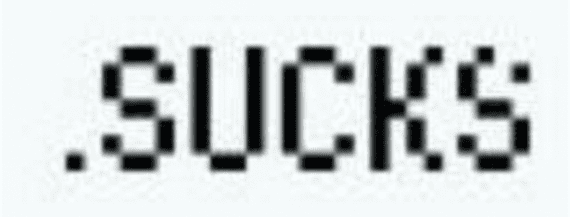The Federal Circuit has agreed with the Trademark Trial and Appeal Board (TTAB) (part of the US Patent and Trademark Office (USPTO)), that stylizing a generic character mark doesn’t make it a source identifier and thus eligible for protection as a trademark.
In Re VOX POPULI REGISTRY LTD. involved the USPTO’s refusal of US Trademark Application Serial No. 87/187,215 (“the ’215 application”) for the image shown above — the stylized form of “.SUCKS.”
As the court explained,
Vox is the domain registry operator for the .SUCKS generic top-level domain (“gTLD”) for Internet websites. A registry operator “maintains the master database of all domain names registered in each top-level domain, and also generates the ‘zone file,’ which allows computers to route Internet traffic to and from top-level domains anywhere in the world.”
Vox filed two trademark applications relevant to “.SUCKS.” One (the ‘941 application) sought registration for the standard character mark “.SUCKS,”
in Class 42 (computer and scientific services) for “[d]omain registry operator services related to the gTLD in the mark” and in Class 45 (personal and legal services) for “[d]omain name registration services featuring the gTLD in the mark” as well as “registration of domain names for the identification of users on a global computer network featuring the gTLD in the mark.”
The other (‘215) application sought to register the stylized form shown above in Class 42 for “domain registry operator services related to the gTLD in the mark.”
The USPTO’s examining attorney refused both applications “on the ground that, when used in connection with the identified services, each fails to function as a mark.”
Vox appealed to the TTAB.
The TTAB affirmed the refusal of the standard character mark, saying .SUCKS “will not be perceived as a source identifier” and instead “will be perceived merely as one of many gTLDs that are used in domain names.”
The same reasoning applied to the stylized version. In addition, the TTAB concluded that
the stylized lettering or design element in the mark does not create a separate commercial impression and is not sufficiently distinctive to ‘carry’ the overall mark into registrability.
Vox then appealed to the Federal Circuit.
Vox argued that the stylized form of .SUCKS appeared as a “‘retro,’ pixelated font that resembles how letters were displayed on early LED screens.”
As the court noted,
Under the Lanham Act, “[n]o [service mark] by which the [services] of the applicant may be distinguished from the [services] of others shall be refused registration on the principal register on account of its nature” subject to certain exceptions. 15 U.S.C. §§ 1052–53. One of these exceptions is that a service mark must function to “identify and distinguish the services of one person . . . from the services of others and to indicate the source of the services.” 15 U.S.C. § 1127. A mark that is, for example, generic or descriptive, fails to function as a source identifier, though descriptive marks can be registered if they have acquired secondary meaning in the perception of consumers…
For example, in U.S. Pat. & Trademark Office v. Booking.com B.V., the US Supreme court rejected the per se rule that “generic.com” names are generic in favor of inquiry based on whether consumers perceive the name as generic.
As the court discussed,
Design or stylization may make an otherwise unregistrable mark registrable if the features “create an impression on the purchasers separate and apart from the impression made by the words themselves.”
The court presented several examples of such stylized marks.
In contrast, the court concluded,
In light of the absence of contrary evidence, the Board reasonably concluded that “given the ubiquity of the design in the ‘early days’ of computing, consumers would view pixelated lettering as ordinary” rather than as a source identifier.
The court thus affirmed the refusal of the trademark application.
Just like the haiku above, we like to keep our posts short and sweet. Hopefully, you found this bite-sized information helpful. If you would like more information, please do not hesitate to contact us here.


